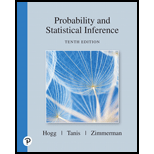
Concept explainers
A life insurance company issues standard, preferred, and ultra-preferred policies. Of the company’s policyholders of a certain age, 60% have standard policies and a
Want to see the full answer?
Check out a sample textbook solution
Chapter 1 Solutions
Pearson eText for Probability and Statistical Inference -- Instant Access (Pearson+)
Additional Math Textbook Solutions
Pathways To Math Literacy (looseleaf)
Introductory Statistics
College Algebra Essentials (5th Edition)
Elementary Statistics: A Step By Step Approach
APPLIED STAT.IN BUS.+ECONOMICS
- Q1. A chest of drawers has 3 drawers. Each drawer has 2 boxes. The boxes of one drawer contain a silver coin in each respectively, the boxes of another a gold coin in each box, and the boxes of the third drawer a gold and a silver coin, respectively. A drawer is selected at random and a box from the drawer is selected at random and opened. The coin is found to be silver. What is the probability that the coin in the other box is gold? (Harder Problem)arrow_forwardPlease solve the following Probability Problem: Show all work and complete what is askedarrow_forwardPlease solve the following probability problem. Show all work and must solve all parts HW 1.z. (Mingle)A number is called and players need to group up and enter rooms. Ifplayers do not manage to make it into the rooms in time, or if a room hasless or more players than it is supposed to have, they will be eliminated.Assume there are 200 people other than you and the number called is 10.Determine the probability that you will form the group of the correct sizein each of the following cases:a) Imagine you had no better strategy than going to each of the 200people and tossing a fair coin to determine if they will join yourgroup or not.b) Imagine everybody else is divided into 25 groups of 4 people and 20groups of 5 people. Among all the possible groups, you are choosingto join two at random.c) Imagine everybody else is divided into 20 groups of 4 people, 10groups of 2 people and 20 groups of 5 people. You are choosing tojoin two groups at random.d) Imagine everybody else is divided into 20…arrow_forward
- Are the two statements A and B equivalent? (A) p~q (B) ~pq ☐ Statement A and B are equivalent. ☐ Statement A and B are not equivalent as their values in three rows are not identical. ☐ Statement A and B are not equivalent as their values in one row is not identical. ☐ Statement A and B are not equivalent as their values in two row are not identical.arrow_forwardLet p, q and r to be True, False and True statements, respectively. What are the values of the statements below. A: B: [(p→q)^~q]→r (pvq) → ~r O O A: False B: False A: True B: True A: False B: True A: True B: Falsearrow_forwardLet's assume p and q are true statements. What are the values of the statements below. A: (p→ q) →~p B: (p v~q) → ~(p^q) A: True B: False A: True B: True ☐ A: A: False B: False ☐ A: False B: Truearrow_forward
- Three statements A, B and C are given below. Which choice is correct? (A) ~(p^~q) (B) ~p^q (c) pv~q ☐ All statements are inequivalent. ☐ Only statements A and B are equivalent. ☐ Only statements C and B are equivalent. ☐ Only statements A and C are equivalent.arrow_forward6: 000 Which truth table is correct for the given compound statement? (pvq)^p]→q A: B: P P 9 [(pvq)^p]→ 9 T T F T T T T F T T F F F T T F T F F F T F F T C: P 9 [(pvq)^p]→9 D: P 9 [pvq)^p]→9 T T T T T T TF T T F F F T F F T T F F F F F T B A D Previous Page Next Page Page 3 of 11arrow_forwardst One Which truth table is correct for the given compound statement? (p→q)^~p A: P q (p→q)^~p B: P q (p→q)^~p T T F T T F T F F T F T F T T F T T F F F F F T C: D: P q (p→ q)^~p P 9 (p→q)^~p T T F T T T T F F T F F F T T F T T F F T F F T A U Oarrow_forward
- A mechatronic assembly is subjected to a final functional test. Suppose that defects occur at random in these assemblies, and that defects occur according to a Poisson distribution with parameter >= 0.02. (a) What is the probability that an assembly will have exactly one defect? (b) What is the probability that an assembly will have one or more defects? (c) Suppose that you improve the process so that the occurrence rate of defects is cut in half to λ = 0.01. What effect does this have on the probability that an assembly will have one or more defects?arrow_forwardA random sample of 50 units is drawn from a production process every half hour. The fraction of non-conforming product manufactured is 0.02. What is the probability that p < 0.04 if the fraction non-conforming really is 0.02?arrow_forwardA textbook has 500 pages on which typographical errors could occur. Suppose that there are exactly 10 such errors randomly located on those pages. Find the probability that a random selection of 50 pages will contain no errors. Find the probability that 50 randomly selected pages will contain at least two errors.arrow_forward
 Holt Mcdougal Larson Pre-algebra: Student Edition...AlgebraISBN:9780547587776Author:HOLT MCDOUGALPublisher:HOLT MCDOUGAL
Holt Mcdougal Larson Pre-algebra: Student Edition...AlgebraISBN:9780547587776Author:HOLT MCDOUGALPublisher:HOLT MCDOUGAL
 College AlgebraAlgebraISBN:9781305115545Author:James Stewart, Lothar Redlin, Saleem WatsonPublisher:Cengage Learning
College AlgebraAlgebraISBN:9781305115545Author:James Stewart, Lothar Redlin, Saleem WatsonPublisher:Cengage Learning- Algebra & Trigonometry with Analytic GeometryAlgebraISBN:9781133382119Author:SwokowskiPublisher:Cengage



